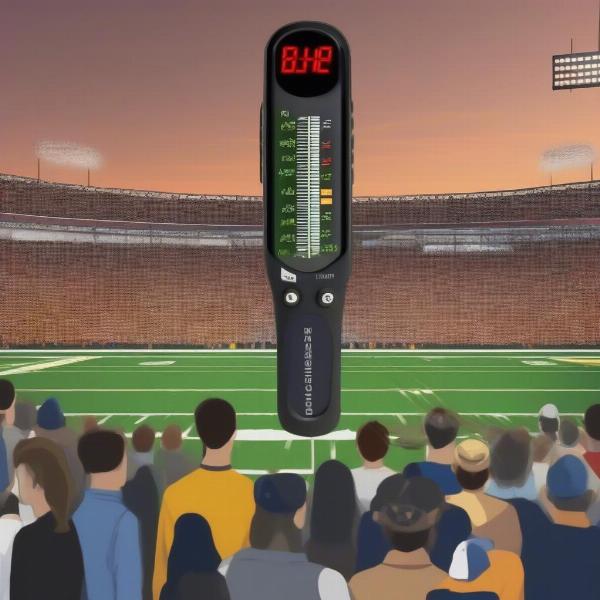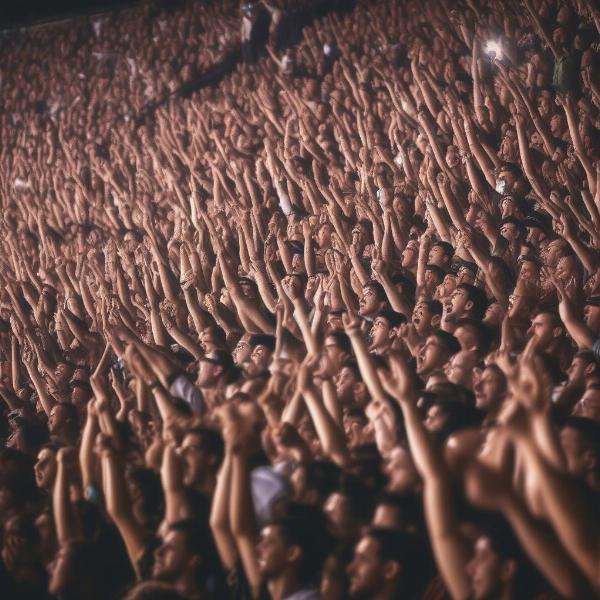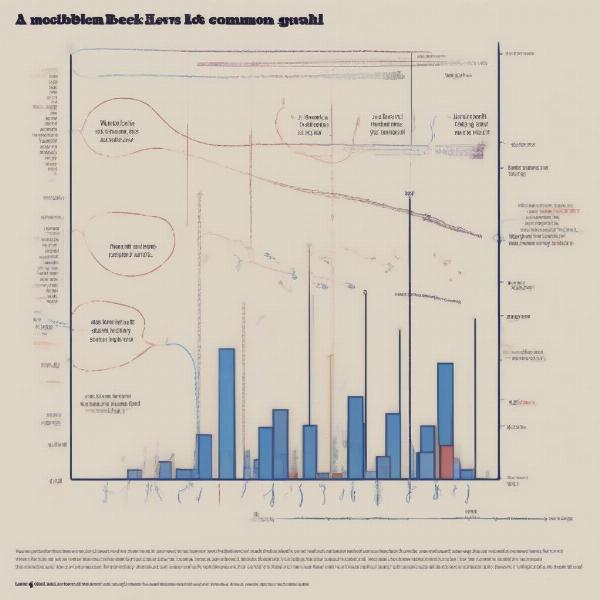Welcome to supremeduelist.blog, your go-to source for all things gaming and beyond. Today, we’re tackling a question that extends past the digital realm and into the roaring stadiums of live sports: What Is The Decibel Level Of A Football Game? This article will dive deep into the science of sound, exploring how loud a football game can get, why it varies, and what factors influence those thunderous roars and hushed breaths of anticipation.
We’ll not only be focusing on the average decibel levels you might encounter, but also the peak noise levels that can occur during pivotal moments in a game. By examining the specific instances and factors impacting sound levels, we can gain a better appreciation for the intense sensory experience of attending a live football match.
Understanding Decibels and Sound Measurement
Before we delve into the specifics of football game noise, it’s essential to understand what a decibel actually represents. A decibel (dB) is a unit used to measure the intensity or loudness of a sound. It’s a logarithmic scale, meaning that a small change in decibels represents a significant change in sound energy. For example, a 10 dB increase is perceived as roughly twice as loud. Everyday sounds like a whisper might register around 30 dB, while a jet engine could reach 140 dB or more. This explains the wide range of sound experiences we encounter daily.
How is Sound Measured at a Football Game?
Sound at a football game is typically measured using handheld sound level meters. These devices capture the intensity of sound waves and convert them into decibel readings. Measurements can be taken from various locations within the stadium – near the field, within the stands, or even outside the venue – to understand the distribution of sound. These readings help assess the overall sound experience, identify potential risks to hearing, and even monitor the effectiveness of stadium design in managing noise levels. It is not only about how loud but where the sound is the loudest.
 Sound measurement at football game
Sound measurement at football game
Average Decibel Levels at a Football Game
The average decibel level at a football game can vary significantly, depending on numerous factors such as the size of the stadium, the number of attendees, and the intensity of the game. Typically, during a regular game, you can expect the sound levels to range from 85 to 100 decibels. This is comparable to the noise of a lawnmower or a busy city street. However, during exciting plays, the crowd’s roar can easily push sound levels much higher.
Factors Influencing Decibel Levels
Several elements can affect the loudness of a football game:
- Crowd Size and Engagement: Larger crowds tend to produce louder sounds. When fans are particularly invested in the game, their cheers, chants, and exclamations can increase the overall decibel level.
- Stadium Design: The architecture of a stadium plays a significant role. Enclosed stadiums tend to amplify sound more effectively than open-air ones. The materials used in construction and the shape of the stadium can also impact sound reflection and absorption.
- Game Intensity: Crucial moments, such as a touchdown or a game-winning play, trigger heightened fan reactions, resulting in louder decibel levels. In close, tight and intense games the average will be higher than a game with a big score gap.
- Use of Sound Enhancements: Some stadiums use sound amplification systems and loud music to create a more engaging atmosphere, further boosting decibel levels. The use of loudspeakers and music can be a huge contributor to overall decibel levels.
- Weather Conditions: Wind, for instance, can carry sound further and may result in a perceived increase in loudness depending on the location of the measurement.
Peak Decibel Levels: The Roar of the Crowd
While the average decibel level is informative, peak sound levels are where the real intensity lies. During particularly electrifying moments, sound levels can spike dramatically. It’s not uncommon for these peak levels to exceed 120 decibels, which is comparable to a jet engine taking off. Such levels can be potentially harmful to hearing over prolonged exposure. These bursts of noise are what make the live experience memorable and intense.
Specific Instances of High Decibel Readings
- Touchdowns: Touchdowns, especially in tight games, are a common trigger for loud outbursts. The explosion of cheers and celebrations can easily generate high-decibel readings.
- Game-Winning Plays: The last-second field goal or an interception in the final moments of the game will create peak decibel readings. The excitement and tension release lead to a massive wave of noise.
- Rivalries: Games between rival teams tend to have higher decibel levels throughout due to heightened fan enthusiasm and anticipation.
- Big Moments: Interceptions, sacks, or incredible catches also usually result in fans reacting explosively to these key events.
- Home Team Advantage: When playing at their home stadiums, fans tend to feel more emotional and supportive leading to higher average decibel level than games away from home.
 Excited crowd reacting at football game
Excited crowd reacting at football game
Are High Decibel Levels Dangerous?
Exposure to high decibel levels, especially prolonged exposure, can pose a risk to your hearing. According to the National Institute for Occupational Safety and Health (NIOSH), exposure to noise levels above 85 dB for extended periods can lead to hearing damage. Considering that peak levels at football games can exceed 120 dB, it’s essential to be aware of the potential risks. While a few hours of exposure may not result in immediate damage, regular exposure could cause long-term hearing problems.
Protecting Your Hearing at Football Games
Here are some steps you can take to protect your hearing at a live football game:
- Use Earplugs: High-fidelity earplugs can reduce the sound level without distorting the audio quality. They are a practical and affordable solution for preserving your hearing.
- Take Breaks: Step away from the loudest areas of the stadium to give your ears a break from the intense noise.
- Monitor Sound Levels: If possible, use a sound level meter app on your smartphone to keep track of the loudness and make informed decisions.
- Limit Exposure: Try not to attend events that consistently expose you to prolonged and loud noise if you are particularly sensitive.
“The roar of a crowd is a major part of the live football experience, but we must also acknowledge the importance of protecting our hearing,” says Dr. Emily Carter, an audiologist specializing in recreational noise exposure. “Long-term exposure to high decibel levels, especially over 100 decibels, can lead to significant and irreversible hearing damage.”
How Loud is a Football Game Compared to Other Events?
To put football game decibel levels into perspective, it’s helpful to compare them to other noisy events:
- Rock Concerts: Rock concerts can easily reach peak levels of 110 to 120 dB, similar to the higher end of a football game.
- Firework Displays: Fireworks can generate peaks of 140 dB or more, which is considerably louder than most football games.
- Motorcycle or Power Tool: Using a motorcycle or power tools may average around 100-110 decibel level.
- Normal Conversation: A normal conversation usually registers around 60 dB.
- Whisper: A whisper is about 30 decibels.
- Home Appliances: A vacuum cleaner can get to about 70 decibels.
 Decibel level comparison graph
Decibel level comparison graph
Frequently Asked Questions
What is the loudest recorded decibel level at a football game?
While there’s no official record universally recognized, there have been reports of decibel levels exceeding 130 dB in certain football stadiums during particularly intense moments. These spikes are often caused by highly enthusiastic fans during critical plays.
Can the sound level at a football game damage your hearing?
Yes, the high decibel levels experienced at football games can cause hearing damage with prolonged exposure, especially during peak moments exceeding 120 dB. Regularly attending games without hearing protection can potentially lead to long-term issues.
Are enclosed stadiums louder than open-air stadiums?
Typically, enclosed stadiums amplify sound more effectively due to the way sound waves are reflected and contained within the structure. This can lead to a generally louder experience compared to open-air stadiums where sound can dissipate more freely.
Do different sections of the stadium have different decibel levels?
Yes, the decibel levels can vary depending on the location within the stadium. Areas closer to the field, especially near loud cheering sections, will generally experience higher decibel levels compared to areas further away or in quieter sections of the stadium.
How do I monitor the decibel levels during a live game?
You can use a sound level meter app on your smartphone, or purchase a dedicated handheld sound level meter. These devices can help you keep track of the noise levels and take action to protect your hearing if needed.
“Understanding the science behind sound can help people enjoy football games while also making informed decisions about their hearing health,” explains James Peterson, an acoustical engineer who has studied stadium sound levels. “It’s a balance between experiencing the thrill and ensuring we are responsible about our long-term health.”
Conclusion
The decibel level of a football game is not a fixed number; it’s a dynamic range influenced by a variety of factors. On average, you might experience levels from 85 to 100 decibels, but during exciting moments, peak levels can exceed 120 dB. While the thrill of a live game is undeniable, it’s crucial to be mindful of potential hearing risks and take necessary precautions. By understanding these dynamics, fans can continue to enjoy the sport while protecting their hearing. Remember to return to supremeduelist.blog for more insights into the science, strategy, and culture of gaming and entertainment. For more information and expert insights into sound in sports and entertainment, be sure to check out our other articles on sound. We hope to see you in the next post.
Leave a Reply